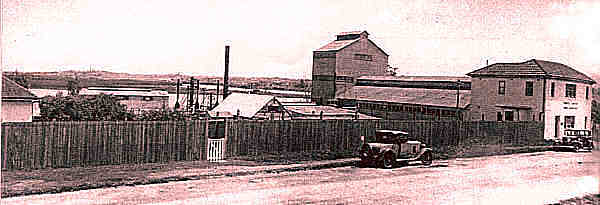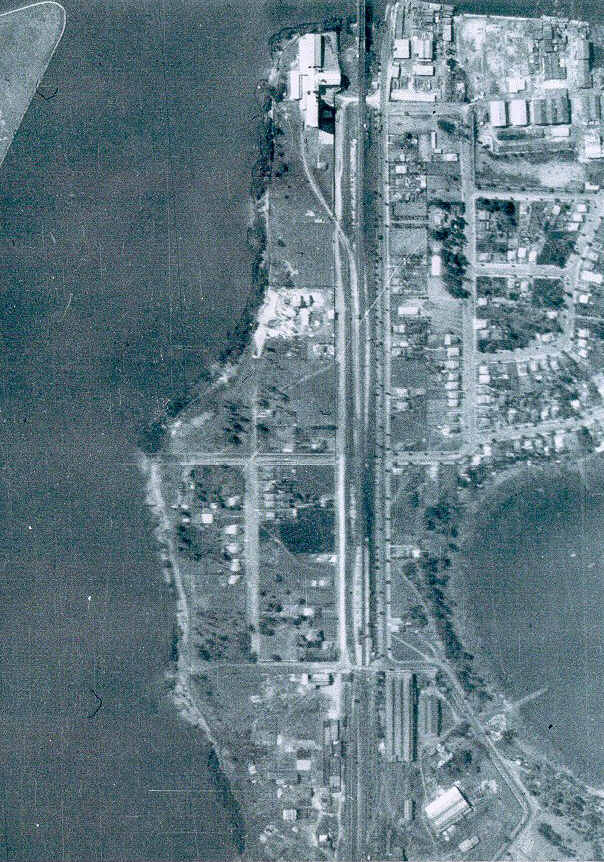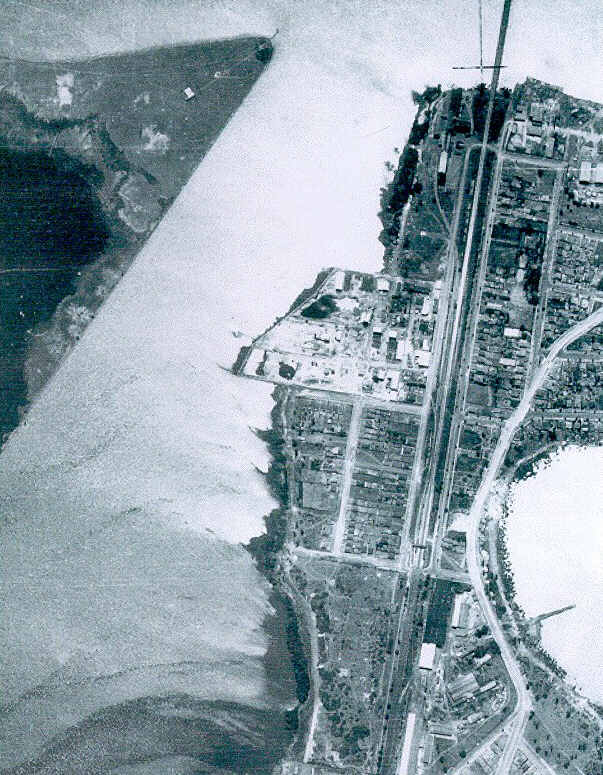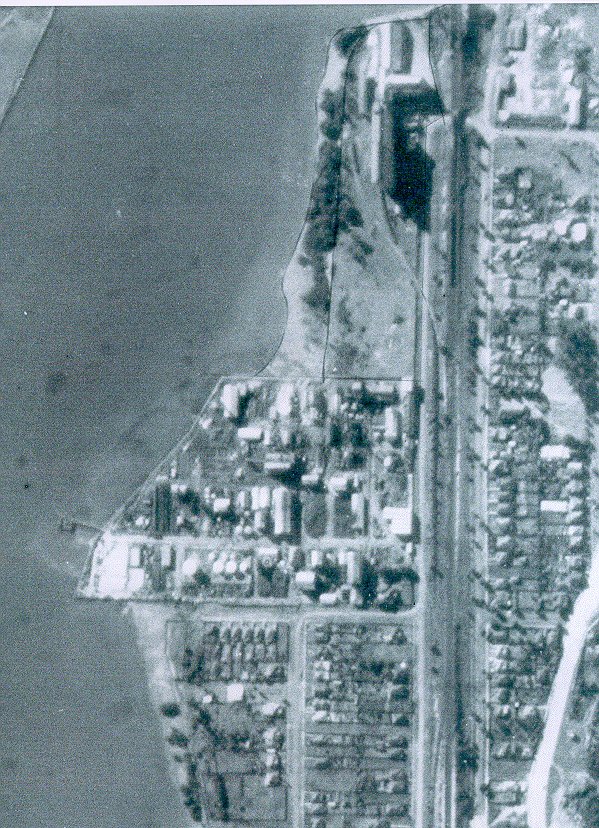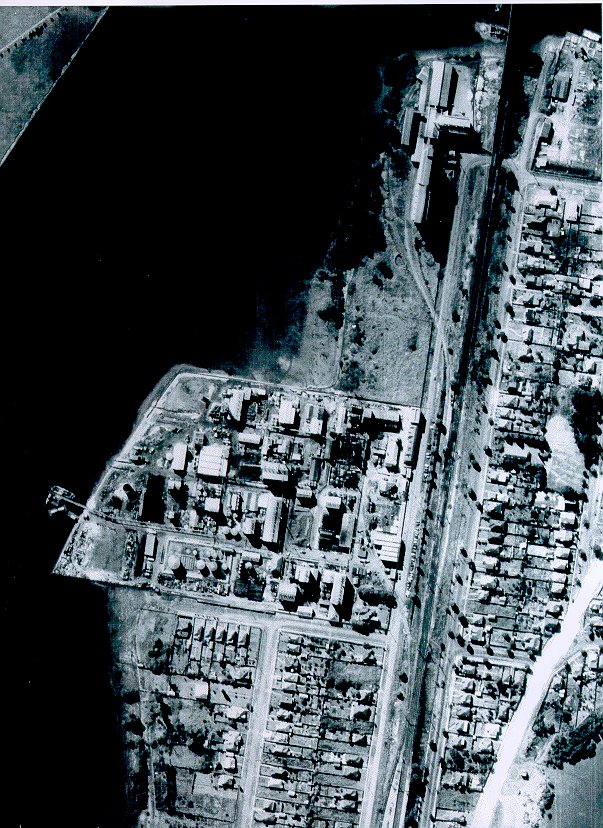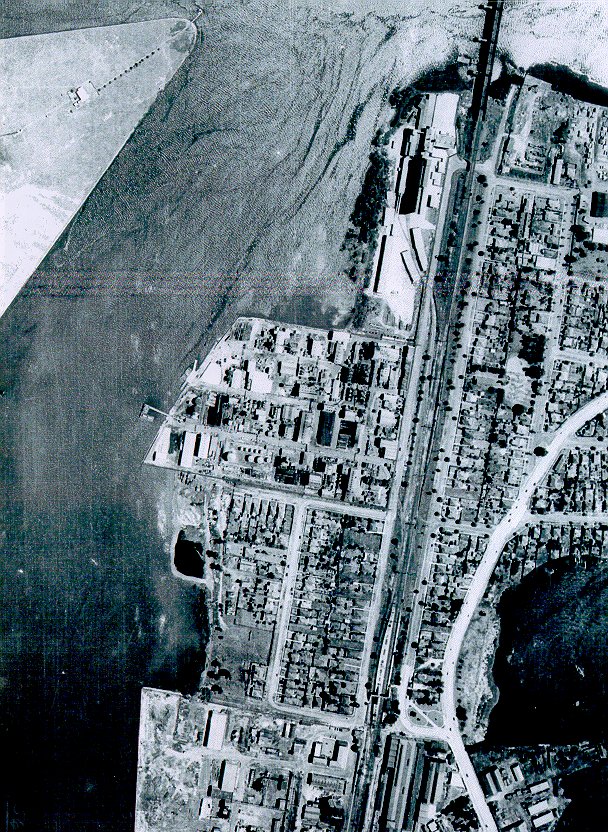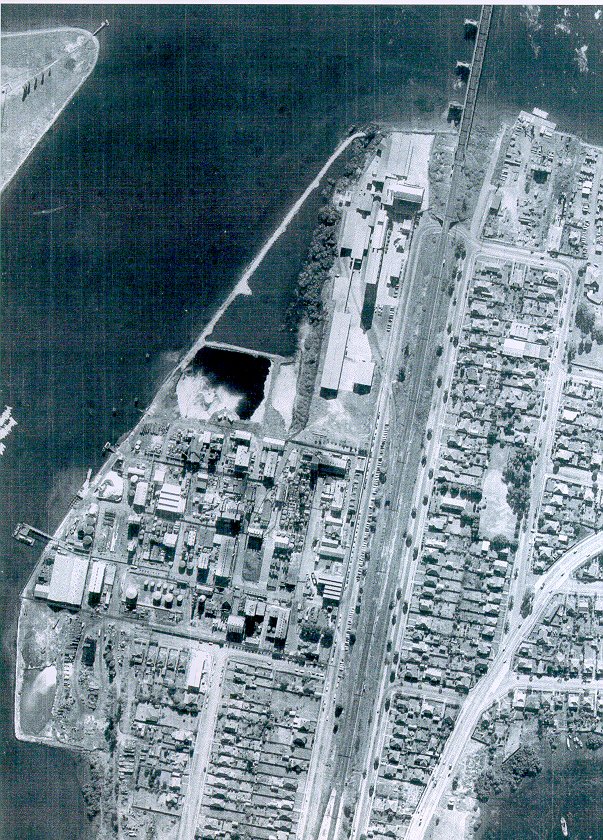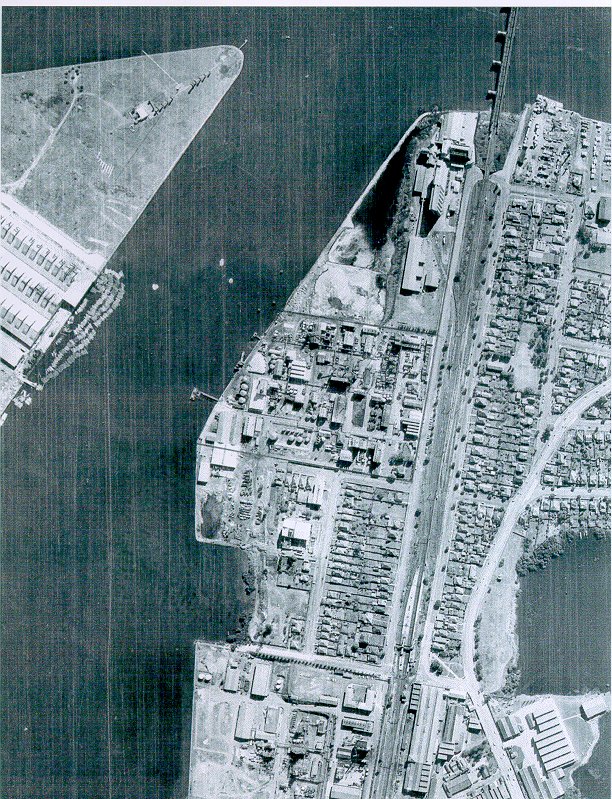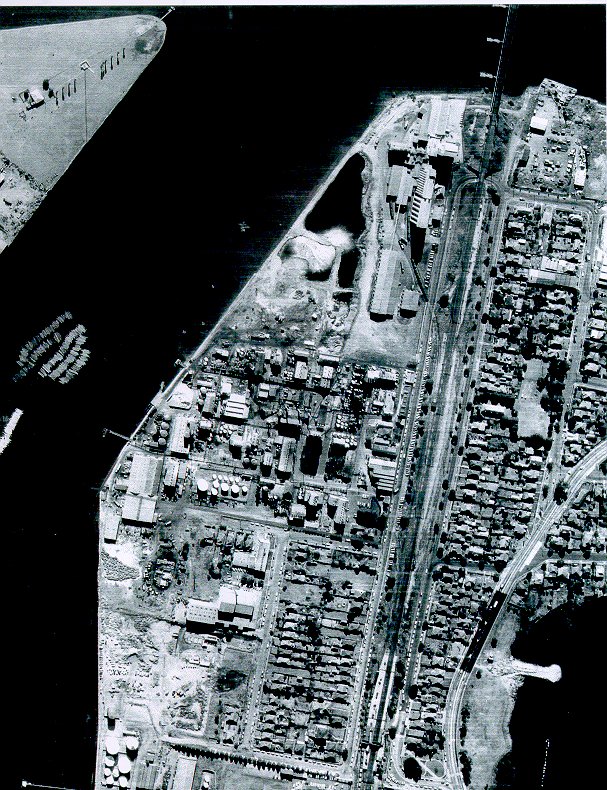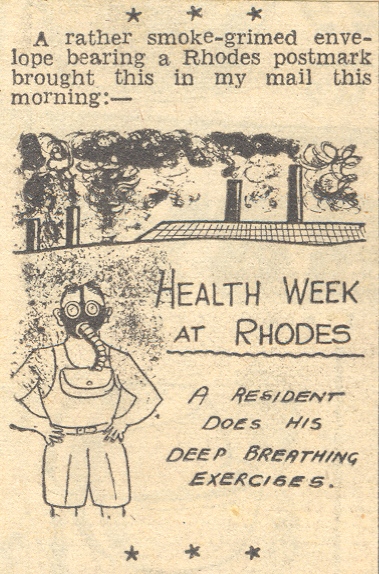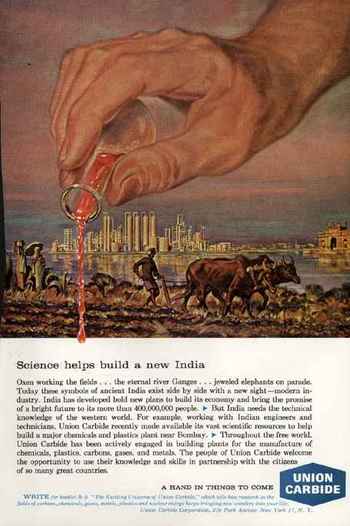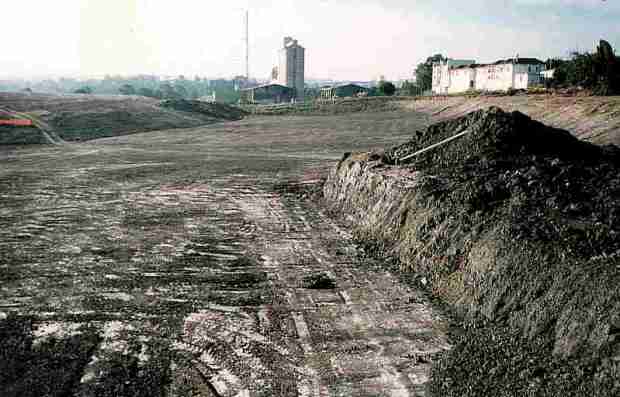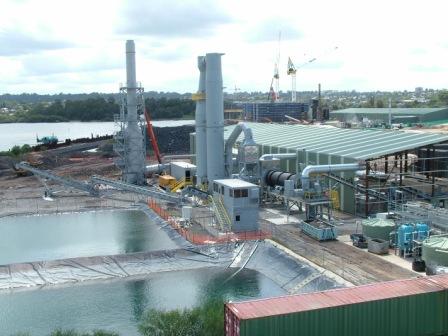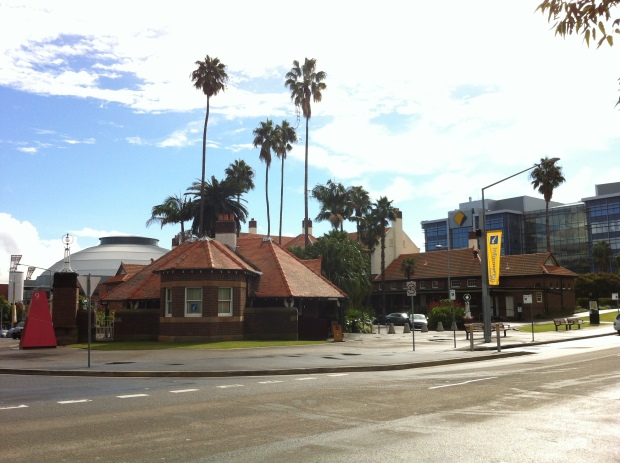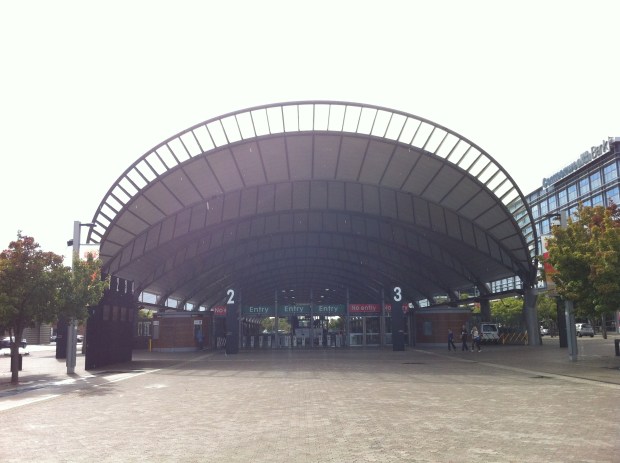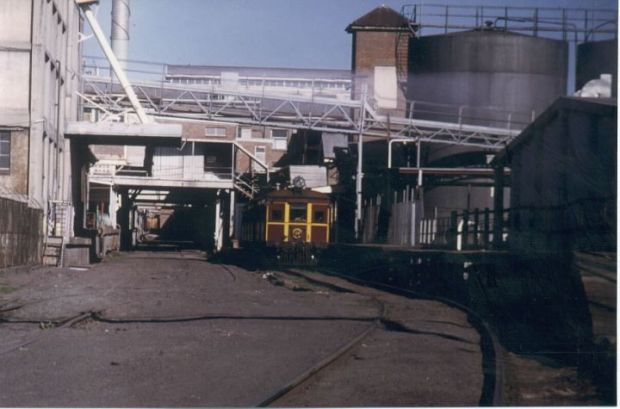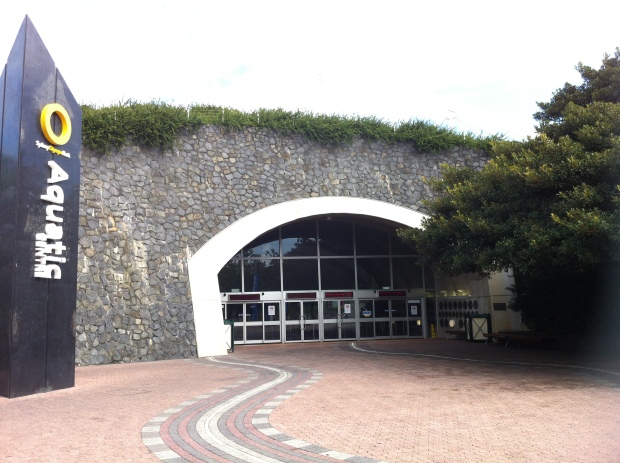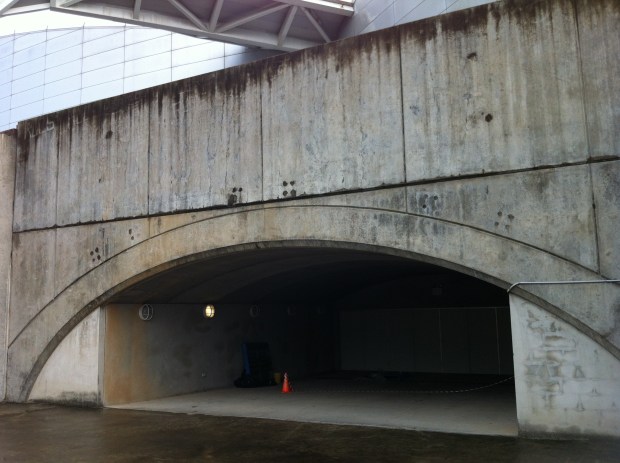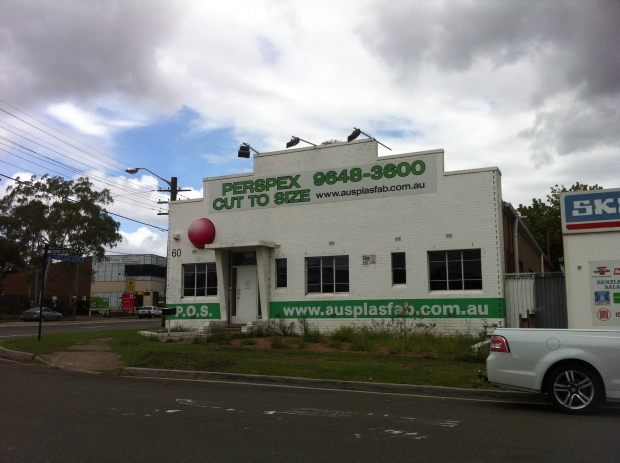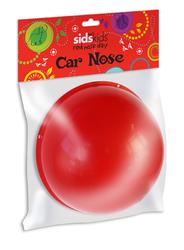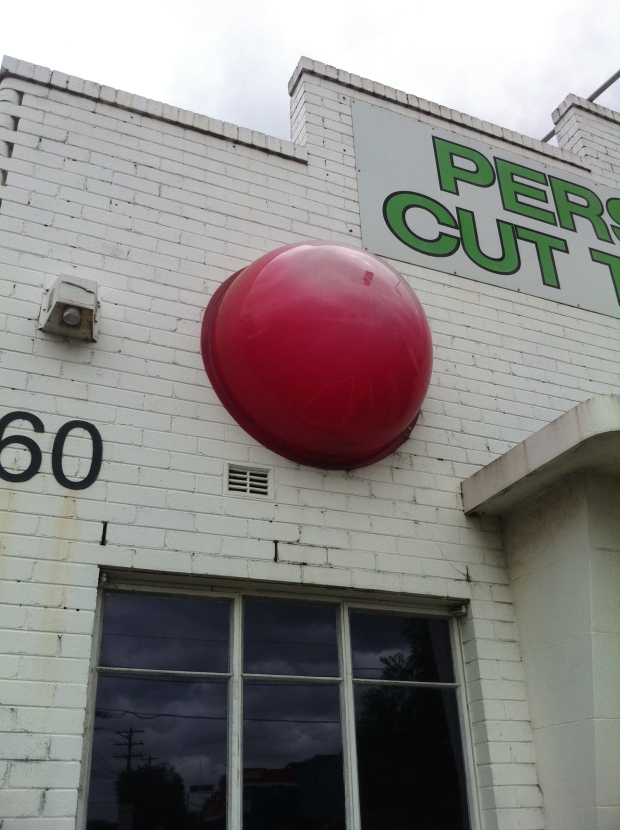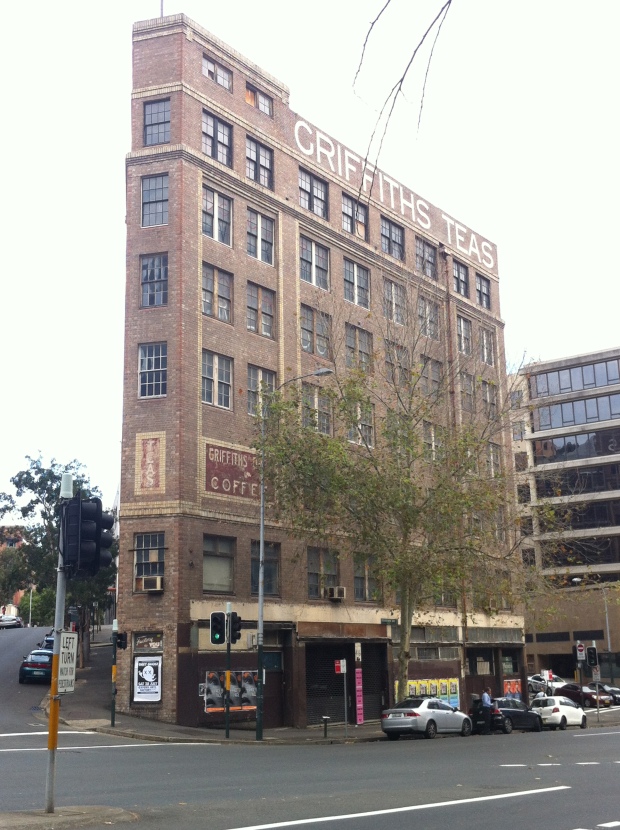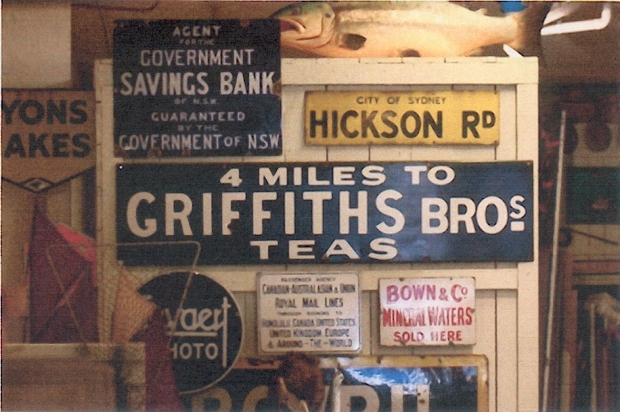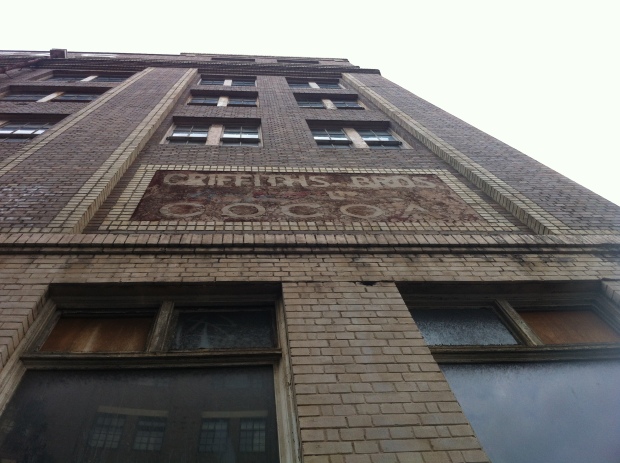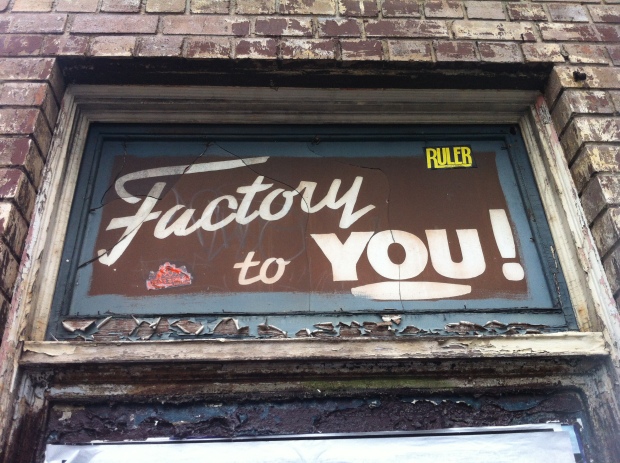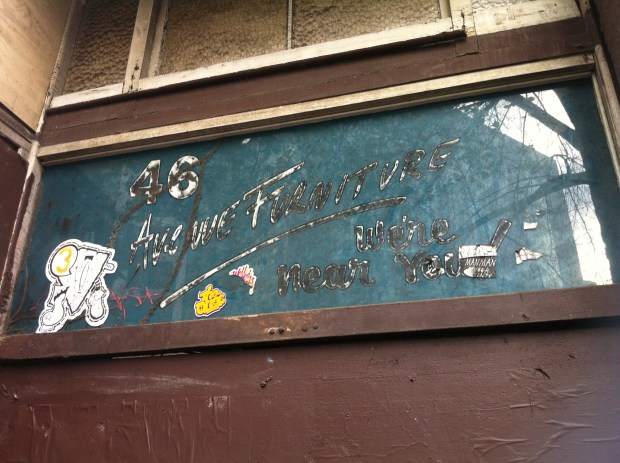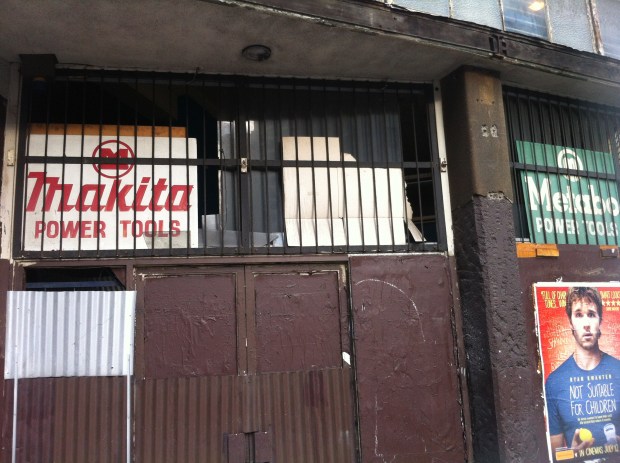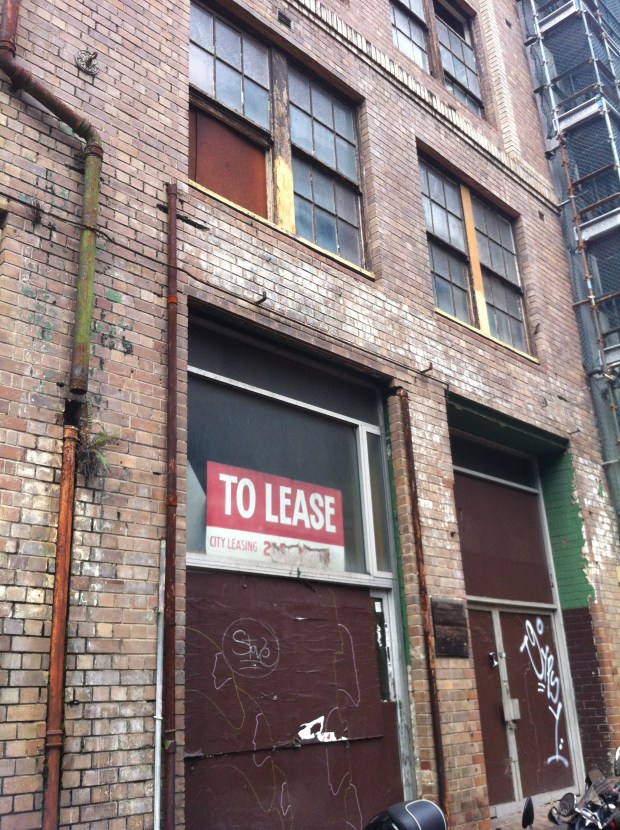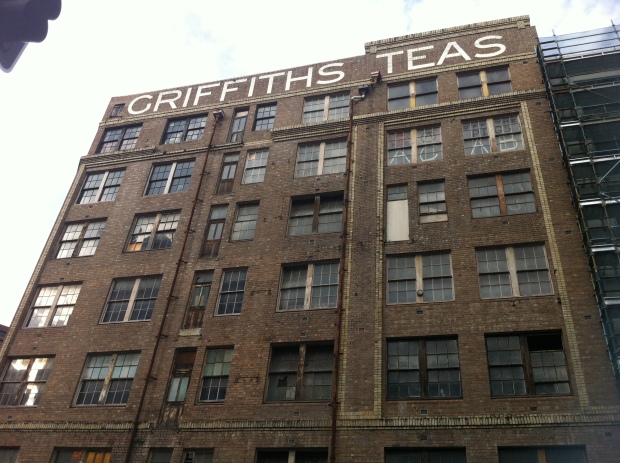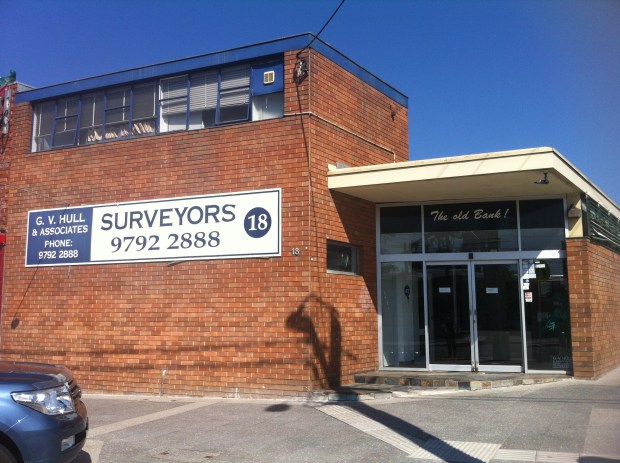Past/Lives Flashback #1: Union Carbide – Rhodes, NSW
Original article: Timbrol Chemicals/Union Carbide/Residential – Rhodes, NSW
Yes, the time has finally come. The most popular entry on Past/Lives over the last year (and a bit, by this point) by far was the tragic tale of Rhodes and that most toxic tenant, Union Carbide. Rhodes’ decimation at the hands of industrial abuse throughout the 20th century and subsequent resurrection as a residential paradise in the 21st is a long story, and one with repercussions for the whole of Sydney even today. Grab a coffee (although Rhodes residents, maybe don’t use tap water) and get comfortable…we’ll be going back over the whole thing.
THEN
Rhodes Hall, near Leeds, was about as far from the eastern shore of the picturesque Homebush Bay as Thomas Walker could imagine. A commissary, Walker had arrived at Port Jackson in 1818, and the following year bought an allotment of land from Frederick Meredith, another early settler. Walker built a house on his bank of the Parramatta River, naming it Rhodes after his grandmother’s estate back in the motherland because even hardened and worldly mercenaries still have soft spots for their grannies. So soft, in fact, that in 1832, Walker moved to Tasmania where he built another estate…also named Rhodes. She must have spoiled that kid rotten.
The Walker family relinquished their control over the Rhodes estate in 1919, when they sold up to the John Darling Flour Mill. By this point, Rhodes was no stranger to industry. Eight years earlier, G & C Hoskins had cleared much of the area’s forests to erect a cast iron foundry, and once this had happened, everyone got on board. There was little resistance to this kind of heavy industrialisation, especially in a suburb like Rhodes, which was easily accessible by rail and water.

Kind of looks like the silhouette of a guy with a ponytail, doesn’t it? Image courtesy City of Canada Bay.
At this point in time, Rhodes and the neighbouring Homebush were the outer limits, truly the Western Suburbs, with only Parramatta and the Blue Mountains more forbidding. Sydneysiders were keen to get the blossoming industrial sector as far away from their own backyards as possible (understandably), and Rhodes, bordered by the new abattoir and the Parramatta River, was out of sight, out of mind.
Flour mills and cast iron foundries weren’t exactly environmentally friendly (a phrase not yet in use in 1928), but the true damage to Rhodes didn’t begin until the arrival of Timbrol Ltd in 1928. Timbrol had been established in 1925 by three Sydney University researchers keen to manufacture their own brand of timber preservative, so at least it was all for a good cause.
In 1933, Timbrol had a breakthrough! It was able to produce the first Australian made xanthates, which is used in the mining sector for extracting particular kinds of ores. With the advent of the Second World War, xanthate exports boomed, and expansion of the Timbrol site was required. But where to go? Sandwiched between the train line and the foreshore, and with John Darling to the north and CSR (another booming wartime chemical company) to the south, Timbrol was apparently out of options.
Just joking. Of course there was an option – the only option: reclaim land from Homebush Bay by filling in the river with contaminated by-products and building over it. Out of sight, out of mind.
The post-war housing boom brought about various new challenges in the domestic domain, most of which could be easily solved with chemicals. Thus, demand for chlorine, herbicides and insecticides, particularly DDT, skyrocketed, and Timbrol was right there to capitalise. And by right there, I mean jutting out over Homebush Bay on new, hastily constructed ground.
Spurring the chemical company’s efforts on even further were their competitors CSR, ICI and Monsanto, most of whom were a stone’s throw away from the Timbrol site. The close proximity of these companies meant that the output of potentially dangerous by-product seemed minimised in the eyes of the era’s governments; it was better for all the companies to be dumping together rather than dumping apart at wider intervals. This also meant that the neighbouring sites could ‘borrow’ Timbrol’s approach to expansion – good news for Homebush Bay.
Timbrol’s success had attracted another element: the American chemical giant Union Carbide, which saw Timbrol as a great place to start an Australian subsidiary. Union Carbide dated back to 1898, and had built its wealth through aluminium production and its zinc chloride battery arm – both of which seem like the perfect thing to manufacture on the bank of a serene body of water.
At this point I’d like to pose a question: when did it ever seem like a good idea to produce chemicals like herbicides, zinc chloride and xanthates beside a healthy bay full of wildlife? Who signed off on this? How were the guys in charge of these companies able to look at this beautiful place and think “Hmm, needs more poison.”? I’m aware that without these chemicals we wouldn’t be able to live the way we do today, but some of these decisions were bordering on just straight up evil.
The arrival of Union Carbide frightened Timbrol’s competitors. The might of the American parent company meant near-unlimited resources, so local campaigns were stepped up.
CSR and even old John Darling began to encroach upon the bay, re-sculpting the landscape as they saw fit.
The initial success of Union Carbide Australia didn’t go unnoticed overseas, either. Associated British Foods bought John Darling’s Flour Mill for its Australian subsidiary Allied Mills in 1960, rebranding it Allied Feeds. Most of the product manufactured at the Allied Feeds site would end up in the stomachs of livestock sent to Homebush Abattoir, where said stomachs would then be carved up to be fed back to the populace. And for that, you need MORE ROOM.
But back to Union Carbide. The early 1960s weren’t kind to UC. Competitors and waning demand had teamed up to diminish the brand, but that didn’t stop the near endless flow of poisons into the bay. By now, nearly all of Union Carbide’s output produced an unfortunate and extremely unpleasant by-product: dioxins. Highly toxic and capable of, at the very least, causing cancer and damaging reproductive and immune systems, dioxins are usually exposed to humans via food particularly meat and fish. What a great idea then to produce extremely unsafe levels of dioxins right beside a manufacturer of animal feed. What a great idea to produce that animal feed on top of land infused with dioxins. What a great idea to expel those unwanted dioxins into Homebush Bay, a waterway directly linked to Sydney Harbour and full of fish.
Let’s take a moment to hear from the World Health Organisation about dioxins:
Short-term exposure of humans to high levels of dioxins may result in skin lesions, such as chloracne and patchy darkening of the skin, and altered liver function. Long-term exposure is linked to impairment of the immune system, the developing nervous system, the endocrine system and reproductive functions. Chronic exposure of animals to dioxins has resulted in several types of cancer. Due to the omnipresence of dioxins, all people have background exposure and a certain level of dioxins in the body, leading to the so-called body burden. Current normal background exposure is not expected to affect human health on average. However, due to the high toxic potential of this class of compounds, efforts need to be undertaken to reduce current background exposure.
So…don’t do what Union Carbide did next, then?
The fortunes of Union Carbide Australia were reversed by the Vietnam War. See, Vietnam has a lot of jungles, and those pesky Vietcong kept hiding in those jungles, so what better way to flush them out than by removing their hiding spot? Union Carbide was contracted by the US military to produce Agent Orange, a dioxide-heavy defoliant. Even when it was discovered that Agent Orange’s components contained a particularly toxic strain of dioxin, it continued to be sprayed indiscriminately throughout the war, during which dioxins continued to be dumped into Homebush Bay.
In the midst of all this, Union Carbide research scientist Douglas Lyons Ford invented Glad Wrap at the Rhodes plant. It was introduced to the Australian market in 1966, the first such product in the country. Well, that kind of balances out that other thing, doesn’t it?
By the 70s, environmental action against companies like these was stepping up, and the population of Sydney had exploded westward. Rhodes’ train line was now a sharp divider between the industrial zone and a booming residential sector.
Further north and across the river, Meadowbank and Ryde were both beginning to cast aside their industrial legacies and welcoming more and more families, while to the south, the Homebush Abattoir was winding down operations. Forward-thinking residential developers were eyeing these areas with great interest, and keeping government wheels greased to ensure their availability in the future. In typical lightning fast Sydney reaction time, this movement was accommodated in the mid-80s by the construction of Homebush Bay Drive, a highway that bypassed the nearby suburb of Concord and tracked through Rhodes’ industrial zone. Out of sight, out of mind.
By the early 1980s, Rhodes was known throughout the land for its toxicity and odour above all else.
Its rich legacy of achievements in the field of chemistry long forgotten, Union Carbide was looking increasingly sick and tired; a relic of another age. But one major incident in 1984 made it look downright villainous.
In December of that year, an explosion at the Union Carbide plant in Bhopal, India exposed half a million people to toxic gases, killing thousands. PR disaster for UC, and the final straw for the parent company. Most of its international subsidiaries were wound up in the years following Bhopal, including the Rhodes plant, which ceased operations in 1985. Allowed to leave without any kind of cleanup effort, Union Carbide left behind a toxic legacy that remains detrimental to Sydney today.
The NSW Government and the Australian Olympic Committee had hoped to transform Rhodes into an Olympic athlete village by the 2000 Sydney games, but they had underestimated just how poisoned the land was.
Government remediation efforts tried in vain between 1988 and 1993 to heal the land, but it wasn’t until 2005, long after the end of the Olympics, that private enterprise intervene with the necessary money and technology to properly clean the land. Why this sudden burst of effective effort so long after the fact?
NOW
Today, if you turn off Homebush Bay Drive at the IKEA, you’ll descend into valleys of glass and steel. Rhodes’ rebirth as a gauntlet of residential and commercial towers, a process which began in 2005, is nearly complete. Sensing an opportunity to make money, Mirvac and other developers pounced on the toxic wasteland at the end of the 90s, saving it from a future of causing people to hold their breath as they drove past.
With a steady flow of money and the promise of even more at the end of the remediation rainbow, Thiess and the NSW Government got to work turning the poisonous dirt into the foundations of the futuristic castles that line the foreshore today.
But while the reclaimed land has been mostly made harmless, the bay has not. In fact, the NSW Department of Health has prohibited fishing west of Sydney Harbour Bridge due to an abundance of dioxins. And swimming? Forget it.
The remediation efforts have been effective in more ways than one. I don’t think that Mirvac and friends really cared about anything other than making the land safe enough to pass re-zoning as residential, but despite this, wetland wildlife has begun to return to the bay. Studies on the sea life are ongoing with hopes that one day the bay will once again be safe, but I don’t think we’ll see it in our lifetime. To my infant readers: this means you too.
To the developers’ credit, the project seems to have largely been a great success. There’s the popular shopping centre, complete with cinema and IKEA (a huge coup in its day, since superseded by Tempe), and Liberty Grove to the east. Care has been taken to eradicate most traces of the industrial nightmare of the past. The new units look good enough to stop you from wondering why the grass is always yellow, and they’re certainly filling up fast. And yet…
If you plant a seed in bad soil, it won’t grow very well. Case in point: this is the unit tower being constructed directly upon the former Union Carbide site. Every other tower in Rhodes is either completed or is only weeks away, but not Union Carbide. In fact, the entire site seems to have been plagued with construction delays or other issues. Sure, this stage of the Rhodes project started later than the others, but that too is down to the sheer toxicity of the Union Carbide land.
At the rear, things look even worse. Piles of dirt sit around, uglifying the scenery. Cranes hover above the unfinished structure like buzzards.
On the corner of Shoreline and Timbrol, construction equipment is a mainstay. It’s as if they just can’t make this one happen, despite their money and intentions.
Tower number two hasn’t even started yet, acting as a base of operations for the workers completing tower number one. In 1997, Greenpeace discovered 36 sealed drums of toxic waste underneath the Union Carbide site, so there’s no telling what these guys are digging up as they go. Does your underground carpark glow in the dark?
Down at the Union Carbide foreshore, an even eerier sight: completed units, completely empty.
These seem to be ready to go, but either due to environmental concerns or the noise of construction, residents aren’t allowed to move in yet. I’d be leaning toward the former reason, seeing as plenty of other people here have to put up with the noise.
The Rhodes experiment has proven to be an environmental triumph, arguably even greater than Sydney Olympic Park, but it’s an even greater financial triumph. The corporations behind the remediation weren’t doing this for the sake of the environment or because they felt like doing something nice, they were doing it for the exact same reason the land was stained in the first place. Rhodes may have gotten the second chance Bhopal never did, but they’re equally valid testaments to that reason.
Past/Lives Flashback #8: Sydney Olympic Park – Homebush, NSW
Original article: NSW State Abattoirs/Sydney Olympic Park – Homebush, NSW
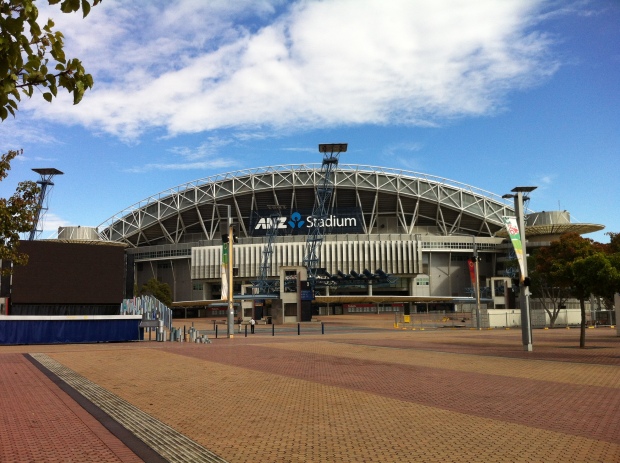 It’s hard to believe it’s been a year since I last visited this place. The blood-soaked history of Sydney Olympic Park is perhaps the most heavily researched article on Past/Lives, yet all that knowledge is quick to fall away when you’re actually standing on site, inhabiting the space where it all went down. The post-Easter Show cleanup only serves to strip back the gaudy decorations designed to distract from the past, leaving today’s visitors with one of two visions: the glorious Olympics, or the violent abattoirs.
It’s hard to believe it’s been a year since I last visited this place. The blood-soaked history of Sydney Olympic Park is perhaps the most heavily researched article on Past/Lives, yet all that knowledge is quick to fall away when you’re actually standing on site, inhabiting the space where it all went down. The post-Easter Show cleanup only serves to strip back the gaudy decorations designed to distract from the past, leaving today’s visitors with one of two visions: the glorious Olympics, or the violent abattoirs.
Apart from the hubbub surrounding the Easter Show, change visits the Olympic zone about as often as I do (read: not much). The stadium seems to have settled on ANZ as its name for the time being, just as the arena’s heart still belongs to Allphones. During my refresher course on the ins and outs of the Olympic era of the site’s history, I laughed when I learned the arena’s actual name is the ‘Sydney Super Dome’. For the first time ever, Allphones sounds comparatively low-key.
So since change is such a stranger here, it’s going to be more beneficial to take a look at some of the landmarks around the Olympic site that betray its brutal past. We didn’t touch on too many last time, with the Abattoir Heritage Precinct being the natural focus. First up is Olympic Park station, the last stop of the train line which delivers thousands of Easter Show-goers to the park each year…
…just as it delivered hundreds of thousands of animals to their deaths each year for decades, some as recently as 25 years ago. Granted, it isn’t the exact same station (although if it was, abattoir workers would have enjoyed the most stylish station in Sydney), but its location is approximate to the original. A complete train line (with stations opening from 1915) served the abattoir and the nearby brickworks, with country trains deviating from the existing rail network at Lidcombe and Flemington to deposit country animals to the abattoir. Employees could catch their own trains from a small platform at the end of Pippita Street, Lidcombe.
As the abattoir declined, the need for employees did so as well, and in 1984 the abattoir line was closed, with the facility itself closing in 1988. The entire Homebush Salesyard Loop, on which the Olympic Park line is based, was closed in 1991. In 1996, the Pippita Street station became the last of the abattoir stations to be demolished, and interestingly, the street itself was absorbed into the huge Dairy Farmers site nearby (now, why do you think that’s there?). The brand-spanking-new Olympic Park loop line opened in 1998, with most of the Homebush Salesyard Loop repurposed to be a part of it.
Now, since that was a little…dry, let’s get wet.
The Sydney Olympic Park Aquatic Centre was the first part of Olympic Park to be constructed following the closure of the abattoir, unless you count Bicentennial Park, which opened in 1988. The Aquatic Centre opened in 1994, with the rest of the park completed by 1996. As such, the Aquatic Centre is the ‘middle child’ of the Olympic Park, with a design sensibility halfway between Bicentennial Park and the stadiums that followed. It’s a strange beast, and one made even stranger by my near-absolute certainty that when it first opened, its entrance was in fact this:
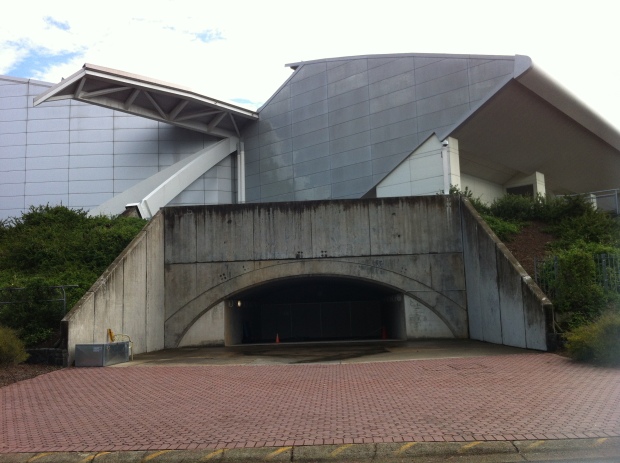 Sometime in 1995, I attended a birthday party at the exciting new Aquatic Centre, which was rumoured on the playground to have a whirlpool and slides. I don’t remember any slides, but I do have a distinct memory of our posse leaving behind a rubber WWF wrestler toy, tossed high up in those bushes on the left in a fit of excitement…while we were hanging around the entrance. Does the Iron Sheik still reside in those bushes today, subsisting on a diet of ants, rainwater and the occasional small bird? Nearly 20 years later, I still wasn’t game enough to climb up and find out. But I did go in for a closer look…
Sometime in 1995, I attended a birthday party at the exciting new Aquatic Centre, which was rumoured on the playground to have a whirlpool and slides. I don’t remember any slides, but I do have a distinct memory of our posse leaving behind a rubber WWF wrestler toy, tossed high up in those bushes on the left in a fit of excitement…while we were hanging around the entrance. Does the Iron Sheik still reside in those bushes today, subsisting on a diet of ants, rainwater and the occasional small bird? Nearly 20 years later, I still wasn’t game enough to climb up and find out. But I did go in for a closer look…
The appearance of those bolt marks, where the original entry sign was probably attached, seems to validate my memory of this being the main entrance. The doors underneath now serve as an emergency exit. If anyone can shed some light on this mystery, drop a line in the comments below. My theory is that when the Aquatic Centre opened, the entrance was here because it faced away from the abattoir site (and at the time, a huge construction site), but when the rest of the park was completed, the entrance was moved around to the opposite end of the facility, a spot which pretty much faces the Abattoir Heritage Precinct (and everything else, in keeping with the Olympic spirit of inclusion and togetherness). Today’s entrance looks a lot more ‘Olympic’ anyway, so it was probably a change for the best. Still…
 Our last stop is just down the road from the Aquatic Centre. Back in the 70s and 80s, Swire (then Woodmasons Cold Storage) would have been one of the places to store the freshly processed animal carcasses on ice before being shipped to the nearby butcheries and markets. For a cold storage facility (and for Dairy Farmers), this was the perfect location…when the abattoir was there. How it’s still able to do business is a stone cold mystery, but I guess that’s why they’re no longer Woodmasons.
Our last stop is just down the road from the Aquatic Centre. Back in the 70s and 80s, Swire (then Woodmasons Cold Storage) would have been one of the places to store the freshly processed animal carcasses on ice before being shipped to the nearby butcheries and markets. For a cold storage facility (and for Dairy Farmers), this was the perfect location…when the abattoir was there. How it’s still able to do business is a stone cold mystery, but I guess that’s why they’re no longer Woodmasons.
See you next time, when we’ll attempt to go for a drive…
Australian Plastic Fabricators – Silverwater, NSW
Now, before any employees of Australian Plastic Fabricators read this and panic – this place is still in business. But for once we’re not interested in the business itself.
For those of you no longer in primary school, it may surprise you to learn that the SIDS and Kids organisation’s Red Nose Day event is still going. A major fundraising initiative to help the fight against sudden infant death syndrome (SIDS), Red Nose Day involves (at least, it did when I was in primary school) buying a plastic red clown-like nose to wear all day, with the money going to SIDS and Kids. Even as a kid, I had a hard time marrying up the concepts of SIDS research and wearing a red nose. I get the idea of being “silly for a serious cause”, but why a red nose? Wouldn’t a rainbow or comically oversized nose be even sillier? Personally, I was always disappointed that the noses didn’t honk. Maybe that was the deluxe model.
During my school years it became a phenomenon akin to the Starlight Christmas ornament scramble. On the last Friday of every June kids went wild for these red noses, and anyone who missed out was for the rest of the day shunned nearly as badly as the kids who dared to wear their red nose the following Monday. I don’t know that many of us actually understood that there was a charity behind the clowning – I suspect had they known they might not have been as enthusiastic.
But for the first ten years or so of its existence, Red Nose Day exploded into the national psyche. You’d see newsreaders, politicians, shopkeepers, anyone who wanted to be seen to be doing some good (or anyone who’d be laughed at anyway) would don the red nose…and always, always Red Symons.
It took off to the extent that SIDS and Kids started producing red noses for cars. For that one wacky day you could surrender your car’s dignity for a good cause, and many, many people did. So ubiquitous was Red Nose Day in my youth, yet so sudden was its disappearance once I reached high school that I was kind of amazed to learn it was still going. Certainly at this Silverwater factory, it’s been Red Nose Day every day for years.
At the height of Red Nose Day mania, SIDS and Kids took the bold step of producing red noses for buildings. This was a risky move: SIDS and Kids had to be sure that the recognition factor of the event was so high that people would know what the hell they were looking at when they saw a giant red dome on the side of any building zany enough to go with it. Maybe this was the case in 1996, but these days, the fading red growth attached to Australian Plastic Fabricators of Silverwater (a suburb no stranger to red noses) doesn’t even give cause for a double take.
That said, I’m sure there are some babies out there who owe their lives to AusPlasFab’s brave choice years ago to look the fool amongst the hardened plastic fabrication industry. By the aged look of this nose, those kids are probably old enough to work here now.
SIDS and Kids’ Red Nose Day will be held again this year (its 25th anniversary) on the last Friday in June. Do your bit and make sure that the only red noses attached to cars this year aren’t those obnoxious Rudolph the Red Nosed Reindeer ones.
Bank/G. V. Hull Surveyors – Revesby, NSW
I love it when they do my job for me.
Of course, what the sign doesn’t say is that between being the old bank and a surveyor with a strong track record of customer satisfaction, it was a video shop. A video shop filled with Street Fighter II Champion Edition arcade machines. Are you telling me there wasn’t room in the above space to paint that bit of history in too?
MANIC UPDATE: Reader Robbo insists that the video shop was a Videomania, whose ilk we’ve encountered before.



